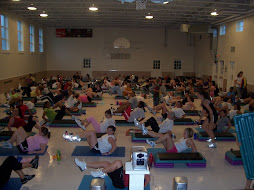skip to main |
skip to sidebar
Third Day of Fitness and Outdoor Exercise Tips
Welcome to Day 3 of the 12 Days of Fitness!
On the third day of fitness, the coalition gave to me:
3 hula hoops (don’t have a hula hoop, just do a hula motion)
2 scissors (feet apart then cross in front, feet apart then cross in back)
and a Partridge in a Yoga Tree-hold a yoga pose
Remember to do all 3 of the exercises that you have learned so far and involve your family members! Check back tomorrow for Day 4!
Just because the temperatures have dropped doesn’t mean you can’t exercise outside, just means you have to take some extra precautions. Check out these tips from http://www.mayoclinic.com/health/fitness/HQ01681- Almost everyone can exercise safely during cold weather. But if you have certain conditions, such as asthma, heart problems or Raynaud's disease, check with your doctor before you work out in cold weather. Your doctor can review any special precautions you need based on your condition or medications you might take.
- Dress in layers that you can remove as soon as you start to sweat and then put back on as needed. First, put on a thin layer of synthetic material, such as polypropylene, which draws sweat away from your body. Avoid cotton, which stays wet next to your skin. Next, add a layer of fleece or wool for insulation. Top this with a waterproof, breathable outer layer. A heavy down jacket or vest may cause you to overheat if you're exercising hard. If you're lean, you may need more insulation than someone who is heavier. If it's very cold, consider wearing a face mask or scarf to warm the air before it enters your lungs.
- Protect hands, feet, and ears-When it's cold, blood flow is concentrated on your body's core, leaving your hands and feet vulnerable to frostbite. Try wearing a thin pair of gloves under a pair of heavier gloves or mittens lined with wool or fleece. Don the mittens or gloves before your hands become cold and then remove them if your hands begin to sweat.
- Considering buying exercise shoes a half-size or one size larger than usual to allow for thick thermal socks or an extra pair of regular socks. And don't forget a hat or headband to protect your ears, which also are vulnerable to frostbite.
Pay attention to weather conditions and wind chill-Exercising when it's cold and raining can make you more vulnerable to the cold. If you get soaked, you may not be able to keep your core body temperature high enough, and layering won't help if your clothes are wet. If it's extremely cold, you may need to take your exercise indoors or skip it for a day or two.
- Wind chill extremes can make exercising outdoors unsafe even if you dress warmly. The wind can penetrate your clothes and remove the insulating layer of warm air that surrounds your body, and any exposed skin is vulnerable to frostbite.
- If the temperature dips well below 0 F (-17.8 C) or the wind chill is extreme, consider taking a break or choosing an indoor activity instead, or take extra precautions if you choose to exercise outdoors anyway.
Choose appropriate gear-If it's dark when you exercise outside, wear reflective clothing. To stay steady on your feet, choose footwear with enough traction to prevent falls, especially if it's icy or snowy. Wear a helmet while skiing, snowboarding and snowmobiling. Consider using chemical heat packs to warm up your hands or feet.
Remember sunscreen-It's as easy to get sunburned in winter as in summer — even more so if you're exercising in the snow or at high altitudes. Wear a sunscreen that blocks both UVA and UVB rays and has an SPF of at least 30. Use a lip balm that contains sunscreen. And protect your eyes from snow and ice glare with dark glasses or goggles.
Drink plenty of fluids-You need to stay well hydrated when exercising in cold weather just as you do when exercising in warm weather. Drink water or sports drinks before, during and after your workout, even if you're not really thirsty. You can become just as dehydrated in the cold as in the heat from sweating, breathing and increased urine production, but it may be harder to notice during cold weather.
Know the signs of frostbite and hypothermia-Frostbite is most common on exposed skin, such as your cheeks, nose and ears, but it also can occur on hands and feet. Early warning signs include numbness, loss of feeling or a stinging sensation. If you suspect frostbite, get out of the cold immediately and slowly warm the affected area — but don't rub it since that can damage your skin. If numbness continues, seek emergency care.
- Exercising in cold, rainy weather increases the risk of hypothermia, as does being an older adult. Hypothermia signs and symptoms include intense shivering, slurred speech, loss of coordination and fatigue. Seek emergency help right away for possible hypothermia.
.jpeg)


No comments:
Post a Comment